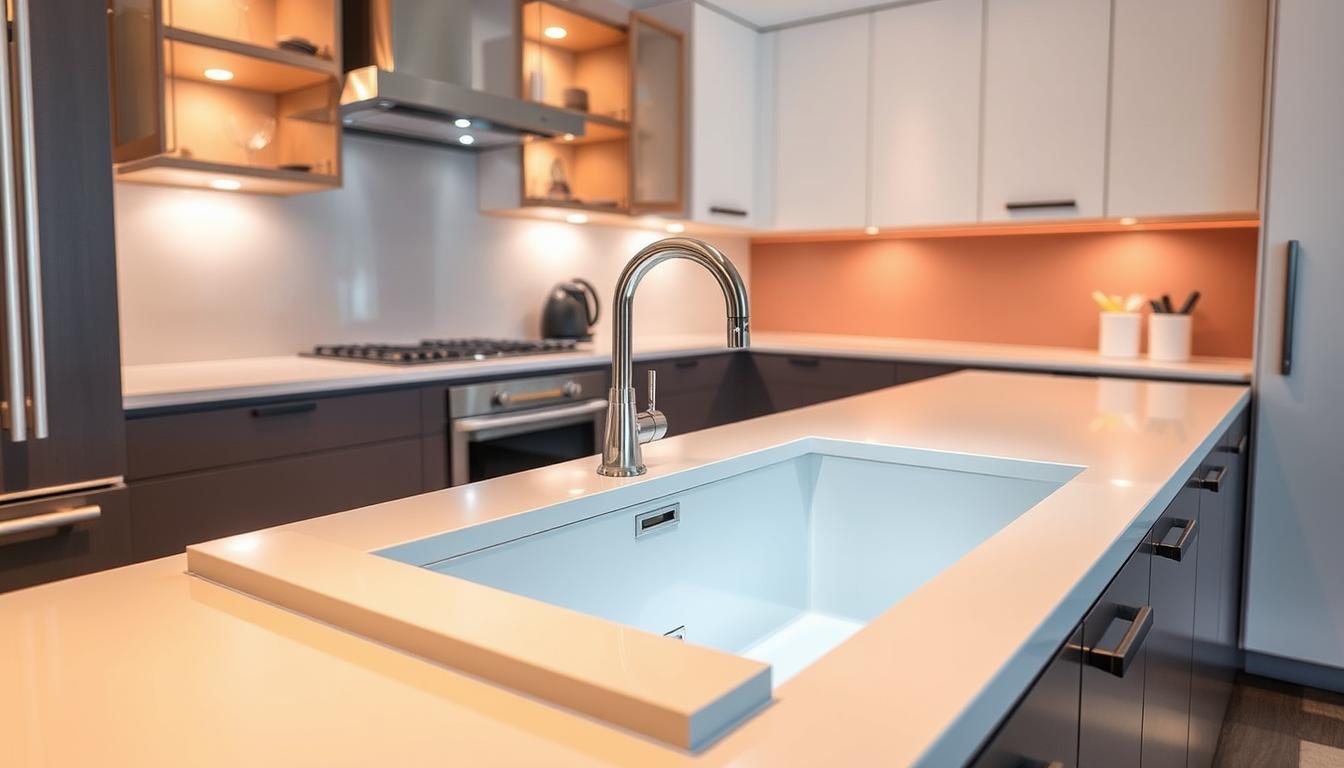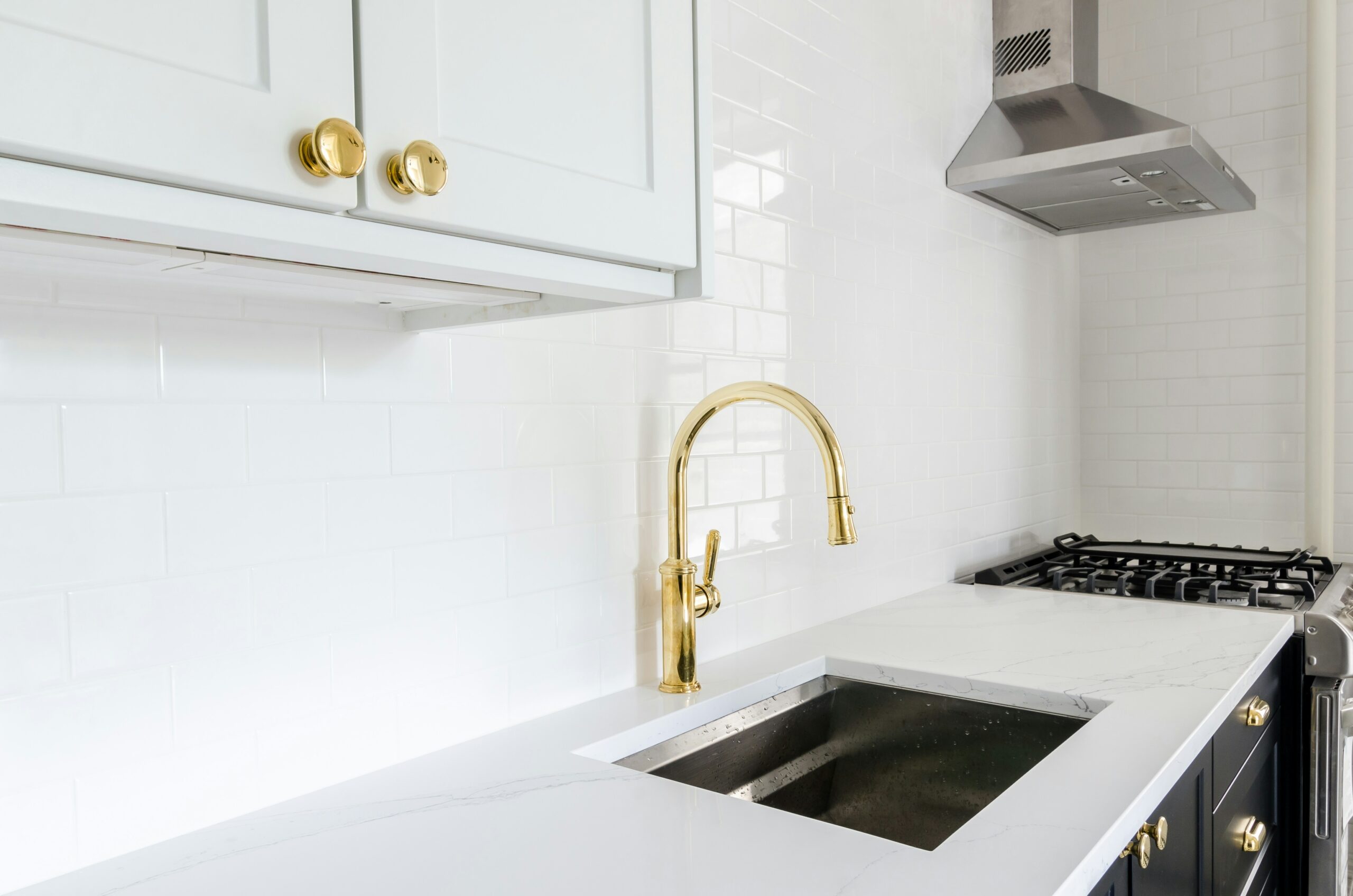5 Kitchen Sink Types
Table of Contents
Your kitchen sink is more than just a place to wash dishes. It’s the heart of your kitchen, where meals are made and memories are created. With many styles to choose from, picking the right one can be fun. Each style, from top-mount to undermount, has its own benefits for your kitchen’s look and feel.
Maybe you love the classic look of a farmhouse sink or the modern feel of an integrated sink. Knowing your options helps you choose wisely. Things like how it’s installed, its shape, material, and look are important. Materials like stainless steel, ceramic, and granite offer different looks and prices.
Key Takeaways
- Explore a wide range of kitchen sink styles, from traditional top-mount to modern undermount.
- Consider factors like installation method, basin configuration, and material composition when selecting a sink.
- Popular sink materials include stainless steel, ceramic, granite, composite, cast iron, copper, and more.
- Understand the unique benefits and considerations of each sink type to find the perfect fit for your kitchen.
- Prioritize functionality, durability, and design aesthetics when making your kitchen sink choice.
Drop-In Kitchen Sinks: The Traditional Choice
Drop-in or top-mount sinks are a favorite among homeowners. They are easy to install and affordable, perfect for DIY projects or budget-friendly updates.
Installation Benefits and Cost Factors
These sinks are installed from above, with the rim supporting the sink’s weight. This makes installation simple, needing only a cut-out in the counter. Drop-in sinks are cheaper to install than undermount sinks, which require more complex mounting.
Maintenance Considerations
The visible sink rim can make cleaning harder. Dirt and debris can collect in the gap between the counter and sink. But, new sink designs with integrated drainboards help keep things clean and improve top-mount sink function.
Design Versatility Options
Despite being traditional, drop-in kitchen sinks come in many materials, styles, and sizes. Homeowners can find one that matches their kitchen’s look. From stainless steel to composite materials, there’s a drop-in sink for every kitchen style.

Undermount Sinks for Modern Kitchens
Looking for a sleek, modern kitchen? Undermount sinks are a great pick. They fit under the countertop, creating a smooth look. This style is both stylish and practical.
Undermount sinks make cleaning up easy. No lip or edges means you can just sweep away messes. They’re also built to last, with materials like stainless steel that resist scratches and stains.
Installing undermount sinks needs a strong countertop, like granite or quartz. It’s best to get a pro to do the job right. They’ll make sure it fits perfectly and works well with your cabinets.
Undermount sinks might cost a bit more than others. But their sleek design and strong build are worth it. They give your kitchen a modern, high-end feel.
Farmhouse Sinks: Merging Style with Functionality
Farmhouse or apron front sinks are now a favorite in modern kitchens. They mix style with practical use. These sinks have a big, single basin and an open front wall. This design makes it easy to wash big items like pots, pans, and large baking dishes.
Material Options for Farmhouse Designs
Homeowners can pick from many materials for farmhouse sinks. Fireclay is durable, stain-resistant, and classic. Stainless steel sinks look modern and sleek. Copper and cast iron add a rustic charm to kitchens. The sink’s material greatly affects your farmhouse kitchen design.
Size and Installation Requirements
Farmhouse sinks need special cabinet changes because of their large capacity and design. They are deeper and wider than usual sinks. So, homeowners must make sure their cabinets can handle the sink’s weight and size.
Installing a farmhouse sink might require extra steps, like cutting the countertop. This can increase costs. But, the sink’s look and function often make it a good investment.
Style Integration Tips
When adding a farmhouse sink to your kitchen, think about how it fits with your design. Apron front sinks can be the room’s centerpiece. So, pick a finish and style that matches your cabinets, countertops, and other elements.
Choose a sink that matches the materials and colors in your space. This creates a unified and attractive look.

Single Basin Kitchen Sink Advantages
Single basin kitchen sinks have unique benefits for today’s homes. They offer a big, open space for washing large items like casserole dishes. This makes them great for kitchens where lots of cooking and cleaning happen.
These sinks also look sleek and simple, fitting well with minimalist kitchen design. They remove the mess of a divided basin, making the kitchen look clean and organized. This design boosts both sink functionality and large capacity.
But, single-basin sinks have a downside. They don’t offer the flexibility of a double-bowl sink, which can handle tasks like food prep and washing dishes at the same time. Homeowners need to think about their kitchen use when choosing between a single or double basin sink.
Single basin sinks work well in both small and large kitchens. They focus on sink functionality and large capacity, making any minimalist kitchen design look and work better.
Double Bowl Configurations: Maximizing Utility
Dual basin sinks, or double bowl configurations, are the most popular choice for kitchen sinks. They offer separate areas for washing and rinsing. This is great for households without dishwashers. The divided design makes multitasking easier, improving dish washing efficiency.
Space Distribution Features
Double bowl sinks give plenty of workspace. But, each basin might be too small for big pots and pans. Some people don’t like the look of double basins, preferring single basin sinks. When picking a dual basin sink, think about the size and depth of each basin. Make sure they fit your kitchen’s needs.
Practical Applications
- Separate areas for washing and rinsing dishes, allowing for efficient multitasking
- Ideal for households without a dishwasher, providing a dedicated space for hand-washing
- Versatile design supports a variety of kitchen tasks, from food preparation to clean-up
Design Considerations
When choosing a dual basin sinks, focus on the size and depth of each basin. Make sure they can hold your biggest pots and pans. Also, think about how they look in your kitchen. Some might like the sleek look of a single basin sink for a modern kitchen.

Corner Kitchen Sink Solutions
Corner sinks are great for small kitchens. They use the corner space with two basins at right angles. Some even have a drying area in the middle, making your kitchen more functional.
Corner sinks are not common and can be pricey. They need special countertops and might affect your kitchen’s structure. Yet, they’re a smart choice for small or odd-shaped kitchens.
- Maximize kitchen corner utilization with double basin sinks
- Integrated drying areas add space-saving functionality
- Unique sink designs for kitchens with limited square footage
- Custom countertop cuts and potential structural impacts to consider
Corner sinks are a good option for small kitchens. They might be tricky to install, but they can change how you use your space.
Integrated Sink Systems: Seamless Design
Kitchen design gets a boost when sink and countertop are one. DuPont (Corian) and Samsung (Staron) make seamless countertops and custom sink designs. These designs get rid of the old rim and seam, keeping your kitchen clean.
This approach not only looks great but also works better. It makes your kitchen more functional and beautiful.
Material Compatibility
Integrated sinks match the countertop material for a perfect look. They come in many colors and finishes. This lets you match your kitchen’s style.
But, these sinks are custom-made. This can make them pricier than usual sinks.
Installation Requirements
Installing integrated sinks is more complex. They’re made as one piece with the countertop. This means you need a careful plan for a perfect fit.
This might take longer and needs a pro’s touch. It’s not a DIY job.
Maintenance Protocol
Integrated sinks can be harder to keep clean. If damaged, they need repair, not just a new one. The seamless design also traps dirt in corners and edges.
Still, they’re popular in modern kitchens. Their sleek look and custom options are appealing to those who want a stylish kitchen.

Bar and Prep Sinks: Secondary Solutions
Kitchen design often focuses on the main sink. But, adding a secondary sink can be very beneficial. Bar and prep sinks are hidden gems that add convenience and functionality.
These sinks are usually found on kitchen islands or counter ends. They measure 15 to 22 inches long and 15 to 25 inches wide. With a depth of 5 to 8 inches, they provide enough space for tasks like bartending and prepping ingredients.
Bar and prep sinks come in various materials like stainless steel, copper, and granite composite. This makes them easy to match your kitchen’s style. Recently, farmhouse-style prep sinks have become popular, adding a rustic charm to modern kitchens.
However, adding a secondary sink might mean less counter space. Before deciding, think about how you entertain and your kitchen’s layout. This will help you decide if a bar or prep sink is right for you.
In conclusion, bar and prep sinks can greatly enhance your kitchen. They offer a dedicated space for food preparation and entertaining. By adding these sinks, you can make your kitchen more functional and versatile.

Low Divider Sink Innovations
Make your kitchen more functional with low divider sinks. They mix the good parts of single and double basin sinks. The divider is only partway up, so you get separation at low water levels and full basin space when needed.
Hybrid Functionality Features
Low divider sinks are great for busy kitchens. They meet your cooking and cleaning needs well. The design is perfect for food prep, keeping ingredients separate while still having room for big pots and pans.
These modern kitchen sinks also make cleaning easier. The small divide means less chance of food getting stuck.
Space Optimization Tips
- The divider is four inches below the rim, making more space for you to work.
- This setup helps you multitask smoothly, moving easily between tasks.
- Low divider sinks combine the look of a single basin with the practicality of a double bowl.
Installation Considerations
Low divider sinks offer flexible sink options, but they might be less common and pricier than double basins. They might also have less room for big items than single basins. Think about them if you want a mix of flexibility and space in your kitchen.
Conclusion: Making Your Kitchen Sink Selection
Choosing the right kitchen sink is all about sink type, material, size, and your needs. If you’re looking for a kitchen sink buying guide, a sink material comparison, or planning a kitchen renovation, there are key things to think about.
Stainless steel sinks are durable, affordable, and versatile. They fit well with many kitchen styles. Meanwhile, materials like granite composite and fireclay offer unique looks and top-notch functionality. They’re perfect for those wanting a luxurious feel.
When picking a sink, think about your budget, how you like to clean, and your kitchen’s design. Different countertops work better with certain sinks and finishes. So, finding the right mix of looks and function is crucial. The best kitchen sink will meet your needs and make your kitchen more beautiful and functional.






